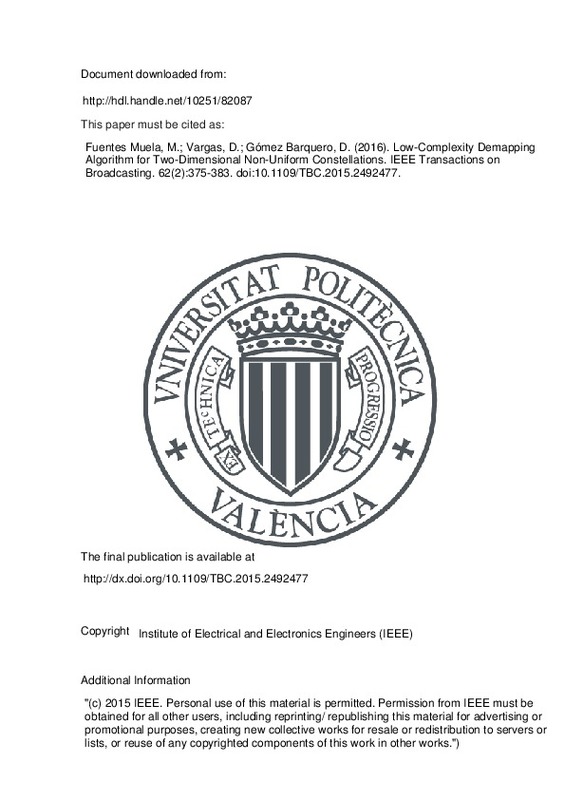JavaScript is disabled for your browser. Some features of this site may not work without it.
Buscar en RiuNet
Listar
Mi cuenta
Estadísticas
Ayuda RiuNet
Admin. UPV
Low-Complexity Demapping Algorithm for Two-Dimensional Non-Uniform Constellations
Mostrar el registro sencillo del ítem
Ficheros en el ítem
| dc.contributor.author | Fuentes Muela, Manuel
|
es_ES |
| dc.contributor.author | Vargas, David
|
es_ES |
| dc.contributor.author | Gómez Barquero, David
|
es_ES |
| dc.date.accessioned | 2017-05-31T10:40:50Z | |
| dc.date.available | 2017-05-31T10:40:50Z | |
| dc.date.issued | 2016-06 | |
| dc.identifier.issn | 0018-9316 | |
| dc.identifier.uri | http://hdl.handle.net/10251/82087 | |
| dc.description | "(c) 2015 IEEE. Personal use of this material is permitted. Permission from IEEE must be obtained for all other users, including reprinting/ republishing this material for advertising or promotional purposes, creating new collective works for resale or redistribution to servers or lists, or reuse of any copyrighted components of this work in other works.") | es_ES |
| dc.description.abstract | Non-uniform constellations (NUCs) have been recently introduced in digital broadcasting systems to close the remaining gap to the unconstrained Shannon theoretical limit. Compared to uniform quadrature amplitude modulation (QAM) constellations, NUCs provide a signal-to-noise ratio (SNR) gain (i.e., a reduction in the required SNR), especially for high-order constellations. One-dimensional NUCs (1D-NUC) have a squared shape with non-uniform distance between the constellation symbols. Since the I and Q components remain as two independent signals, a 1D-demapper as for uniform QAM constellations is feasible. Two-dimensional NUCs (2D-NUC) provide a better performance than 1D-NUCs, since they are designed by relaxing the square shape constraint, with arbitrary shape along the complex plane. However, the main drawback of 2D-NUCs is the higher complexity at the receiver, since a 2D-demapper is needed. In this paper, we propose a demapping algorithm that reduces from 69% to 93% the number of required distances when using 2D-NUCs. The algorithm discards or replicates those constellation symbols that provide scarce information, with a performance degradation lower to 0.1 dB compared to the optimal maximum likelihood demapper. | es_ES |
| dc.language | Inglés | es_ES |
| dc.publisher | Institute of Electrical and Electronics Engineers (IEEE) | es_ES |
| dc.relation.ispartof | IEEE Transactions on Broadcasting | es_ES |
| dc.rights | Reserva de todos los derechos | es_ES |
| dc.subject | ATSC 3.0 | es_ES |
| dc.subject | Broadcasting | es_ES |
| dc.subject | Demapping complexity | es_ES |
| dc.subject | Non-uniform constellations | es_ES |
| dc.subject.classification | TEORIA DE LA SEÑAL Y COMUNICACIONES | es_ES |
| dc.title | Low-Complexity Demapping Algorithm for Two-Dimensional Non-Uniform Constellations | es_ES |
| dc.type | Artículo | es_ES |
| dc.identifier.doi | 10.1109/TBC.2015.2492477 | |
| dc.rights.accessRights | Abierto | es_ES |
| dc.contributor.affiliation | Universitat Politècnica de València. Instituto Universitario de Telecomunicación y Aplicaciones Multimedia - Institut Universitari de Telecomunicacions i Aplicacions Multimèdia | es_ES |
| dc.description.bibliographicCitation | Fuentes Muela, M.; Vargas, D.; Gómez Barquero, D. (2016). Low-Complexity Demapping Algorithm for Two-Dimensional Non-Uniform Constellations. IEEE Transactions on Broadcasting. 62(2):375-383. doi:10.1109/TBC.2015.2492477 | es_ES |
| dc.description.accrualMethod | S | es_ES |
| dc.relation.publisherversion | http://dx.doi.org/10.1109/TBC.2015.2492477 | es_ES |
| dc.description.upvformatpinicio | 375 | es_ES |
| dc.description.upvformatpfin | 383 | es_ES |
| dc.type.version | info:eu-repo/semantics/publishedVersion | es_ES |
| dc.description.volume | 62 | es_ES |
| dc.description.issue | 2 | es_ES |
| dc.relation.senia | 313641 | es_ES |







![[Cerrado]](/themes/UPV/images/candado.png)

